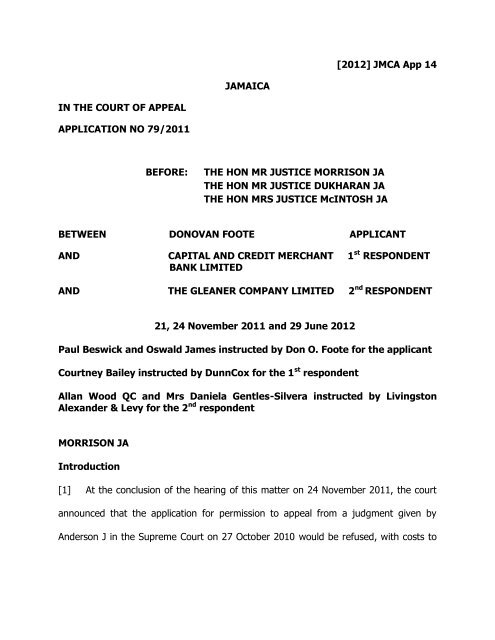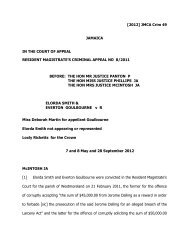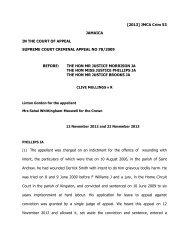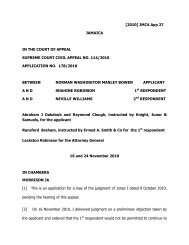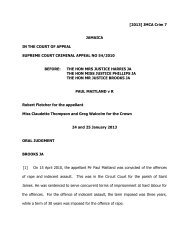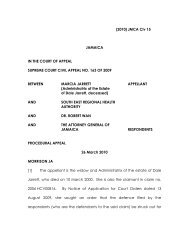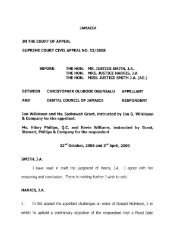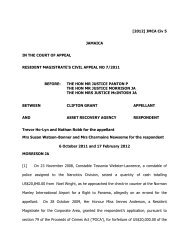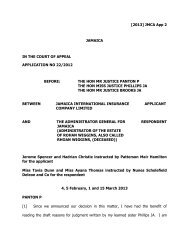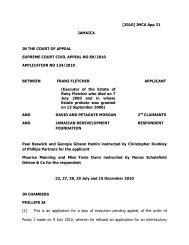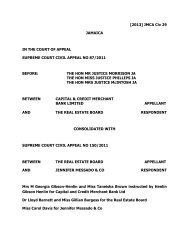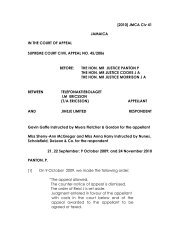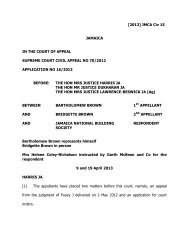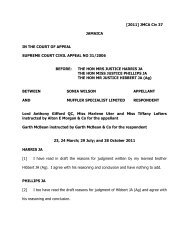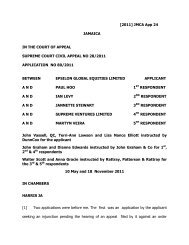Foote (Donovan) v Capital & Credit Merchant Bank Ltd & Anor.pdf
Foote (Donovan) v Capital & Credit Merchant Bank Ltd & Anor.pdf
Foote (Donovan) v Capital & Credit Merchant Bank Ltd & Anor.pdf
Create successful ePaper yourself
Turn your PDF publications into a flip-book with our unique Google optimized e-Paper software.
[2012] JMCA App 14<br />
JAMAICA<br />
IN THE COURT OF APPEAL<br />
APPLICATION NO 79/2011<br />
BEFORE:<br />
THE HON MR JUSTICE MORRISON JA<br />
THE HON MR JUSTICE DUKHARAN JA<br />
THE HON MRS JUSTICE McINTOSH JA<br />
BETWEEN DONOVAN FOOTE APPLICANT<br />
AND CAPITAL AND CREDIT MERCHANT 1 st RESPONDENT<br />
BANK LIMITED<br />
AND THE GLEANER COMPANY LIMITED 2 nd RESPONDENT<br />
21, 24 November 2011 and 29 June 2012<br />
Paul Beswick and Oswald James instructed by Don O. <strong>Foote</strong> for the applicant<br />
Courtney Bailey instructed by DunnCox for the 1 st respondent<br />
Allan Wood QC and Mrs Daniela Gentles-Silvera instructed by Livingston<br />
Alexander & Levy for the 2 nd respondent<br />
MORRISON JA<br />
Introduction<br />
[1] At the conclusion of the hearing of this matter on 24 November 2011, the court<br />
announced that the application for permission to appeal from a judgment given by<br />
Anderson J in the Supreme Court on 27 October 2010 would be refused, with costs to
the 1 st and 2 nd respondents, to be agreed or taxed. These are my reasons for<br />
concurring in the court’s decision.<br />
[2] On 4 November 2010, the applicant moved this court for permission to appeal<br />
against Anderson J’s judgment, the learned judge having previously refused an oral<br />
application for permission made to him immediately after he had delivered his<br />
judgment. The application was accompanied by a draft of the notice and grounds of<br />
appeal, the judgment of Anderson J and an affidavit of the applicant in support. On 18<br />
November 2010, written submissions in opposition to the application were filed on<br />
behalf of the 2 nd respondent.<br />
[3] On 10 January 2011, the application was considered by Panton P, who issued the<br />
following direction to the Registrar:<br />
“I intend to deal with this matter on paper. Kindly ascertain<br />
whether the applicant has anything to say in response to the<br />
submissions filed by [the 2 nd respondent’s attorneys-at-law]<br />
on 18 November 2010. If he has, submissions are to be<br />
filed within seven days of the communication of this<br />
instruction to him.”<br />
[4] On 19 January 2011, in response to this direction, the applicant filed written<br />
submissions in answer to the 2 nd<br />
respondent’s submissions opposing the grant of<br />
permission to appeal, together with authorities in support, and two additional affidavits.<br />
[5] On 4 April 2011, after consideration of the matter on paper, Panton P made the<br />
following order:<br />
“I have considered the submissions. The judgment of<br />
Anderson J. seems unassailable. In the circumstances,
section 106 of the Registration of Titles Act stands firmly in<br />
the path of the applicant.<br />
The application for permission to appeal is accordingly<br />
refused. Costs of the application to the respondent Gleaner<br />
Co. to be agreed or taxed.”<br />
[6] By this application, the applicant seeks an order discharging Panton P’s order, on<br />
the ground that the application for permission to appeal, being one which the judge<br />
was minded to refuse, ought not to have been considered and refused without the<br />
applicant having been given a hearing. In support of the application, the applicant<br />
places particular reliance on rule 1.8(6) and (7) of the Court of Appeal Rules, 2002 (‘the<br />
CAR’).<br />
[7] Section 11(1)(f) of the Judicature (Appellate Jurisdiction) Act provides that no<br />
appeal shall lie to this court from any interlocutory order without the leave of the judge<br />
of the court below or of the Court of Appeal, save in certain specified cases, none of<br />
which is applicable in the instant case. It is common ground that in the instant case an<br />
appeal from Anderson J’s judgment required leave, or, in the more modern usage of the<br />
Civil Procedure Rules, 2002 (‘the CPR’) and the CAR, ‘permission’. It is also common<br />
ground that, as I have already indicated, the applicant, as he was obliged to do by<br />
virtue of rule 1.8(2) of the CAR, did in fact seek leave in the first place from the learned<br />
judge, who refused to grant it.
[8] Rule 1.8 of the CAR prescribes the procedure by which permission to appeal may<br />
be obtained from this court, where it is required.<br />
Particularly relevant are subparagraphs<br />
(5), (6) and (7), which are in the following terms:<br />
“(5) An application for permission to appeal made to the<br />
court may be considered by a single judge of the<br />
court unless it is an appeal involving a sentence of<br />
death.<br />
(6) The judge may give permission without hearing the<br />
applicant.<br />
(7) However if the judge is minded to refuse<br />
permission he or she must direct –<br />
(a)<br />
(b)<br />
that a hearing in chambers be fixed; and<br />
whether that hearing is to be by a single<br />
judge or the court.” [Emphasis supplied]<br />
[9] The clear intent of the rules is therefore that, while applications for permission to<br />
appeal can ordinarily be considered and determined by the single judge on paper<br />
without hearing the parties, in cases in which the judge forms the view that the<br />
application should be refused, he or she is obliged to afford the applicant an<br />
opportunity to be heard, either before the judge in chambers or the court itself.<br />
[10] Understandably, and quite properly, Mr Wood QC was careful to point out that<br />
(i) Panton P had given the applicant an opportunity to provide him with written<br />
submissions to the 2 nd respondent’s submissions opposing the grant of permission to<br />
appeal (para. [3] above); (ii) the applicant duly availed himself of that opportunity<br />
(para. [4] above]); and (iii) the applicant did not indicate to the learned President that<br />
he wished to be heard in chambers. However, there can, in my view, be no doubt that<br />
a ‘hearing’ for the purposes of rule 1.8(7) plainly connotes “an opportunity to state
one’s case” (Concise Oxford English Dictionary, 11 th edn, page 658) in a formal setting,<br />
in the presence of the respondents; and further, that it is the obligation of the single<br />
judge (“he or she must direct” - emphasis supplied) to give the applicant an<br />
opportunity to be heard in these circumstances. I accordingly consider that, no such<br />
opportunity having been afforded the applicant in the instant case, the learned<br />
President fell into error.<br />
[11] While this conclusion sufficed to dispose of the application that was actually<br />
before the court, that is, to discharge Panton P’s order, it nevertheless appeared to the<br />
court that remitting the matter to the President, or another judge, to consider the<br />
application for permission to appeal would not be an optimum use of judicial time.<br />
Accordingly, with the agreement of the parties, the court therefore proceeded to<br />
consider the application for permission afresh.<br />
The factual background<br />
[12] The factual background to the application is as follows. Up to 15 February 2008,<br />
the applicant was the registered proprietor of commercial premises situated at 103 East<br />
Street in the city and parish of Kingston, and registered at Volume 1226 Folio 539 of<br />
the Register Book of Titles (‘the premises’). The applicant occupied these premises as<br />
offices for the purposes of his practice as an attorney-at-law. The 1 st respondent was<br />
the registered mortgagee of the premises, under the terms of an instrument of<br />
mortgage dated 2 May 1995, given by the applicant to the 1 st respondent to secure an
indebtedness of $2,000,000.00, with interest (‘the mortgage’). Included in the parties’<br />
mutual agreements recorded in clause two of the mortgage was the following:<br />
“The statutory powers of sale and of appointing a Receiver<br />
and all powers conferred on mortgagees by the Registration<br />
of Titles Act may be exercised by the Mortgagee not only on<br />
the happening of the events mentioned in the said Act but<br />
also upon any default after any demand for payment of the<br />
moneys hereby secured or any part thereof or immediately<br />
upon any other default in or non-compliance with any of the<br />
covenants conditions or obligations on the part of the<br />
Mortgagor herein contained or hereunder implied without it<br />
being necessary in any one or more of such cases to serve<br />
any notice or demand on the Mortgagor anything in the<br />
Registration of Titles Act or any other Act or Law to the<br />
contrary notwithstanding BUT upon any sale made under<br />
the statutory power in that behalf the purchaser shall not be<br />
bound or concerned to see or enquire whether such sale is<br />
consistent with this proviso and if a sale is made in breach<br />
thereof the title of the purchaser shall not be impaired on<br />
that account.”<br />
[13] The applicant having defaulted in payments under the mortgage, the 1 st<br />
respondent issued proceedings against him in 1998 (Claim No C.L. C-069 of 1998), to<br />
recover the amount owing to it under the mortgage. Further, by notice dated 1<br />
February 1999, over the hand of its attorneys-at-law, the 1 st respondent notified the<br />
applicant that the amount owing under the mortgage as at 31 January 1999 was<br />
$4,795,553.97, being $1,946,940.29 for principal and $2,848,913.68 for interest. That<br />
notice also advised the applicant that, in the event of continued default in payment for<br />
a period of one month after service of the notice on him, “the Mortgagee will sell the<br />
mortgaged premises in exercise of the Powers of Sale contained in the Act and the said<br />
Mortgage”. This notice was sent to the applicant by the 1 st respondent’s said attorneys-
at-law by registered and ordinary post addressed to the address for service specified in<br />
the mortgage instrument.<br />
[14] On 16 July 2003, final judgment by consent was entered in the court proceedings<br />
in the 1 st respondent’s favour in the sum of $3,526,002.61, inclusive of interest and<br />
costs (‘the consent judgment’).<br />
A subsequent arrangement made between the 1 st<br />
respondent and the applicant, whereby the former agreed to pay the sum of<br />
$20,000.00 per month commencing March 2004 towards settlement of the debt due to<br />
the latter, appears to have fallen through, as a result of the applicant’s non-compliance<br />
with its terms. By letter dated 24 August 2005, the 1 st respondent advised the<br />
applicant that, in the event of his failure to clear the shortfall by 31 August 2005, “we<br />
will instruct our attorneys to resume legal actions through the Courts”. There is no<br />
evidence of any further payments having been made in response to this ultimatum.<br />
[15] At some point in the first quarter of 2007, it came to the applicant’s attention<br />
that the 2 nd<br />
respondent was interested in purchasing the property from the 1 st<br />
respondent, acting pursuant to its powers of sale in the mortgage. As a result, the<br />
applicant approached the 2 nd respondent directly by way of a letter dated 2 March 2007<br />
(‘the 2 March 2007 letter’), which is in the following terms:<br />
“2 nd March 2007<br />
The Gleaner Company Limited<br />
7 North Street
Kingston<br />
Attention: Miss Shena P. Stubs [sic] – Legal Officer<br />
Dear Madam,<br />
RE: Purchase of Lot 103 East Street, Kingston<br />
Thanks for bringing to my attention the Gleaner’s endeavour to<br />
purchase the captioned property (my legal office) which came to<br />
me as a surprise.<br />
I respect the fact that you have brought same to my attention and<br />
appreciate your offer to work with me to accommodate my needs.<br />
I must bring to your attention however that the two (2)<br />
mortgagees with interest in the property are in Court with the<br />
matter and there are judgments in their favour to satisfy there [sic]<br />
interest in the property. One is by consent and the other is<br />
presently on appeal.<br />
It is questionable therefore whether they can properly exercise any<br />
power of sale in your favour which they might have without my<br />
knowledge and consent [emphasis in the original].<br />
In order to be able to let you know my position I would need to<br />
know and have full disclosure of the terms and condition of the<br />
purported sale to you of my property.<br />
Yours truly,<br />
____________________<br />
DON O. FOOTE<br />
Attorney-at-Law”<br />
[16] In due course, by an agreement for sale dated 5 July 2007, the 1 st respondent,<br />
in its capacity as mortgagee, agreed to sell the premises to the 2 nd respondent for the<br />
sum of $6,400,000.00. This sale was completed by the registration of a transfer of the
premises in favour of the 2 nd respondent as proprietor in fee simple on 15 February<br />
2008. Even after application of the net proceeds of the sale to the mortgage debt, the<br />
1 st respondent maintained that there remained a balance of $2,467,378.71 due to it.<br />
Claim No HCV – 3328 of 2008 (‘the current action’)<br />
[17] On 8 July 2008, the applicant filed the current action in the Supreme Court<br />
against the respondents for the following:<br />
(1) Damages for “Breach of Contract/Consent Judgment<br />
and/or Inducement of Breach of contract and/or<br />
improper wrongful exercise of power of Sale”;<br />
(2) an order setting aside the sale by the 1 st respondent to<br />
the 2 nd respondent;<br />
(3) injunctions restraining the 2 nd respondent from (i)<br />
“transferring by sale or otherwise the said property to<br />
anyone other than the [applicant]” and (ii) recovering<br />
possession of the premises from the applicant “without<br />
an order of this Honourable Court”;<br />
(4) exemplary and/or aggravated damages.<br />
[18] The applicant’s claim against the 2 nd respondent was set out in paragraph 12 of<br />
his particulars of claim, as follows:<br />
“The 2 nd [respondent], well knowing at all material times<br />
that the 1 st [respondent] had entered into a Consent<br />
Judgment with the [applicant] with respect to the<br />
[applicant’s] said property wrongfully interfered in the
performance of the said Consent Judgment with intent to<br />
injure the [applicant] and so procured/induced and/or<br />
facilitated the 1 st [respondent] to breach the said Consent<br />
Judgment.” (Emphasis in the original)<br />
In particularising this allegation against the 2 nd respondent, the applicant made specific<br />
reference to the 2 March 2007 letter.<br />
[19] In its defence dated 27 August 2008, the 2 nd respondent denied that it acted in<br />
breach of the consent judgment. Specifically, the 2 nd respondent pleaded as follows (at<br />
paragraph 8):<br />
“…the 2 nd [respondent] says that it had no legal obligation<br />
pursuant to the Registration of Titles Act to make inquire to<br />
[sic] as to whether the [applicant] was in default with<br />
payment of his mortgage; whether the default continued;<br />
whether notice of default was given to the [applicant] by the<br />
1 st [respondent] and consequently upon which whether the<br />
1 st [respondent] properly exercised its powers of sale as a<br />
mortgagee. The 2 nd [respondent] admits that by letter<br />
dated 2 March 2007 the [applicant] advised it of the<br />
existence of the Consent Judgment but denies that this<br />
knowledge deprived the 1 st [respondent] from exercising its<br />
powers of sale under the mortgage.”<br />
[20] On 3 February 2009, in an action which had previously been filed by the 2 nd<br />
respondent in the Corporate Area Resident Magistrate’s Court against the applicant for<br />
recovery of possession of the premises (Plaint No. 2641 of 2008), Her Honour Miss<br />
Judith Pusey made an order that the action should “be transferred to the Supreme<br />
Court to be joined with Claim No. 2008 HCV – 3328”.
The strike out application<br />
[21] By notice of application for court orders filed on 9 March 2010, the 2 nd<br />
respondent moved the court for an order striking out the applicant’s statement of case<br />
in the current action on the basis that “(a) it discloses no reasonable grounds for<br />
bringing the claim against the [2 nd respondent] and (b) it is an abuse of the process of<br />
the Court”. The grounds of the application were as follows:<br />
“1. Section 106 of the Registration of Titles Act provides<br />
that upon a mortgagee selling a mortgaged premises a bona<br />
fide purchaser for value is not bound to enquire if the power<br />
of sale was properly exercised, and the remedy for any<br />
person who feels aggrieved by the exercise of the power of<br />
sale is against the mortgagee in damages.<br />
2. On the 5 th day of July, 2007 the First [respondent]<br />
entered into an agreement for sale as mortgagee to sell the<br />
mortgaged premises to the Second [respondent] and the<br />
sale was completed and the transfer registered on the 15 th<br />
February, 2008.<br />
3. The action filed discloses no reasonable grounds for<br />
bringing the action against the Second [respondent] and is<br />
an abuse of the process of the Court and therefore ought to<br />
be struck out pursuant to Rule 26.3 of the Civil Procedure<br />
Rules 2002.”<br />
[22] The application was supported by a brief affidavit sworn to by Miss Shena<br />
Stubbs, a legal advisor to the 2 nd respondent, which simply rehearsed the details of the<br />
2 nd respondent’s purchase from the 1 st respondent. Miss Stubbs’ affidavit also exhibited<br />
the agreement for sale dated 5 July 2007 and a copy of the duplicate certificate of title<br />
registered at Volume 1226 Folio 539 of the Register Book of Titles, with the transfer
from the 1 st respondent to the 2 nd respondent duly registered thereon on 15 February<br />
2008.<br />
[23] The procedural basis for the strike out application in this case is to be found in<br />
rule 26.3 of the CPR, which is in the following terms:<br />
“26.3 (1) In addition to any other powers under these<br />
Rules, the court may strike out a statement of case or part<br />
of a statement of case if it<br />
appears to the court –<br />
(a)<br />
(b)<br />
(c)<br />
(d)<br />
…;<br />
that the statement of case or the part to be struck out<br />
is an abuse of the process of the court or is likely to<br />
obstruct the just disposal of the proceedings;<br />
that the statement of case or the part to be struck out<br />
discloses no reasonable grounds for bringing or<br />
defending a claim;…<br />
….”<br />
[24] The application also called for a consideration of the provisions of section 106 of<br />
the Registration of Titles Act (‘the RTA’). Because section 105 also has a bearing on the<br />
matter, it may be helpful to set out both sections before considering Anderson J’s<br />
judgment:<br />
“105 – A mortgage and charge under this Act shall, when<br />
registered as hereinbefore provided, have effect as a<br />
security, but shall not operate as a transfer of the land<br />
thereby mortgaged or charged; and in case default be made<br />
in payment of the principal sum, interest or annuity secured,<br />
or any part thereof respectively, or in the performance or<br />
observance of any covenant expressed in any mortgage or<br />
charge, or hereby declared to be implied in any mortgage,<br />
and such default be continued for one month, or for such<br />
other period of time as may therein for that purpose be
expressly fixed, the mortgagee or annuitant or his<br />
transferees, may give to the mortgagor or grantor or his<br />
transferees notice in writing to pay the money owing on<br />
such mortgage or charge, or to perform and observe the<br />
aforesaid covenants (as the case may be) by giving such<br />
notice to him or them, or by leaving the same on some<br />
conspicuous place on the mortgaged or charged land, or by<br />
sending the same through the post office by a registered<br />
letter directed to the then proprietor of the land at his<br />
address appearing in the Register Book.<br />
106 - If such default in payment, or in performance or<br />
observance of covenants, shall continue for one month after<br />
the service of such notice, or for such other period as may in<br />
such mortgage or charge be for that purpose fixed, the<br />
mortgagee or annuitant, or his transferees, may sell the land<br />
mortgaged or charged, or any part thereof, either altogether<br />
or in lots, by public action or by private contract, and either<br />
at one or at several times and subject to such terms and<br />
conditions as may be deemed fit, and may buy in or vary or<br />
rescind any contract for sale, and resell in manner aforesaid,<br />
without being liable to the mortgagor or grantor for any loss<br />
occasioned thereby, and may make and sign such transfers<br />
and do such acts and things as shall be necessary for<br />
effectuating any such sale, and no purchaser shall be bound<br />
to see or inquire whether such default as aforesaid shall<br />
have been made or have happened, or have continued, or<br />
whether such notice as aforesaid shall have been served, or<br />
otherwise into the propriety or regularity of any such sale;<br />
and the Registrar upon production of a transfer made in<br />
professed exercise of the power of sale conferred by this Act<br />
or by the mortgage or charge shall not be concerned or<br />
required to make any of the inquiries aforesaid; and any<br />
persons damnified by an unauthorized or improper or<br />
irregular exercise of the power shall have his remedy only in<br />
damages against the person exercising the power.”<br />
The judge’s conclusion on the strike out application<br />
[25] At the end of an obviously carefully considered judgment, Anderson J concluded<br />
as follows (at para. 35):
“Based upon the analysis above and my view of the<br />
authorities, I have formed the view that any question as to<br />
the proper exercise of the power of sale is one to be<br />
determined between the claimant and the mortgagee. It is<br />
not an issue which is of concern to the purchaser and the<br />
remedy for the mortgagor who was [sic] been wronged, if it<br />
turns out to be the case is in damages pursuant to section<br />
106 of the Registration of Titles Act. In the circumstances,<br />
the claim against the 2 nd defendant ought to be struck out<br />
as it discloses no cause of action against that defendant. I<br />
also award costs of this application to the 2 nd defendant<br />
Gleaner, to be taxed if not agreed.”<br />
The applicant’s submissions to this court<br />
[26] The burden of Mr Beswick’s submissions for the applicant was that (i) the<br />
protection given to a purchaser from a mortgagee by section 106 of the RTA could only<br />
be relied on where the power of sale had actually arisen, which it had not in this case,<br />
and (ii) the 2 nd respondent had been put on notice by the 2 March 2007 letter that the<br />
power of sale had not arisen and this sufficed to deprive the 2 nd respondent of the<br />
protection of section 106, which was not available to a purchaser who was not<br />
innocent. Mr Beswick then stated explicitly that the applicant’s position was that he had<br />
not been aware of the 1 st respondent’s exercise of its power of sale and, as a result, the<br />
2 nd respondent could not rely on section 106. This last submission drew an immediate<br />
protest from both Mr Bailey and Mr Wood, on behalf of the 1 st and 2 nd respondents<br />
respectively, both gentlemen pointing out that it went further than the applicant’s<br />
original pleading in the matter. As it turned out, there would be more to come on this<br />
particular point as the hearing progressed.
[27] With regard to the criteria for the grant of leave to appeal, Mr Beswick referred<br />
us to the 1990 decision of the Court of Appeal of England and Wales in The Iran<br />
Nabuvat [1990] 3 All ER 9, in which it was held that the purpose of requiring leave to<br />
appeal was to screen out appeals which would inevitably fail and that all that was<br />
required of an applicant for leave was to show that there was an arguable case on<br />
appeal. On the substantive issue of whether the 2 nd respondent was entitled to rely on<br />
the protection of section 106, Mr Beswick complained that neither of the authorities<br />
upon which Anderson J mainly based his decision (Waring (Lord) v London &<br />
Manchester Assurance Co <strong>Ltd</strong> & Others [1934] All ER Rep 642 and Lloyd<br />
Sheckleford v Mount Atlas Estate <strong>Ltd</strong>, SCCA No 148/2000, judgment delivered 20<br />
December 2001) was of any assistance in determining the question to which the facts<br />
of this case had given rise. To the contrary, he submitted, this case was covered by the<br />
authority of the older cases of Jenkins v Jones (1866) 66 ER 43 and Selwyn v Garfit<br />
(1888) 39 Ch D 273, both of which the learned judge had distinguished on their facts.<br />
[28] Finally, Mr Beswick drew to our attention a document headed “Amended<br />
Equitable Relief/Counterclaim”, which had apparently been filed on the applicant’s<br />
behalf in the 2 nd respondent’s action in the Resident Magistrate’s Court on 21 November<br />
2011. In that document, in a section marked “Defence”, the applicant had specifically<br />
raised the issue of fraud against the 2 nd<br />
respondent and accordingly, Mr Beswick<br />
submitted, he was entitled to have his day in court on that issue.
A new affidavit<br />
[29] At the close of Mr Beswick’s submissions on 21 November 2011, the hearing of<br />
the application was adjourned, for continuation on 24 November 2011. On 23<br />
November 2011, in direct response to Mr Beswick having told the court in his<br />
submissions that the applicant’s position was that he had not received any notice of the<br />
1 st respondent’s intention to exercise its powers of sale, an affidavit was filed on the 1 st<br />
respondent behalf by Mr Peter Depass, the attorney-at-law who had represented it in<br />
connection with that matter. I cannot avoid setting out in full all but the purely formal<br />
parts of that affidavit:<br />
“1. …<br />
2. That I am duly authorized to swear to this Affidavit on<br />
behalf of the 1 st Respondent in opposition to the application<br />
herein to discharge the order of the Honourable Mr. Justice<br />
Panton P. made on the 4 th of April 2011 and I do so from<br />
facts and matters within my own personal knowledge, save<br />
where stated by me to the contrary, and that the<br />
information contained herein is true to the best of my<br />
knowledge, information and belief.<br />
3. That I am reliably informed by Mr. Courtney Bailey,<br />
Attorney-at-Law of DunnCox, Attorneys-at-Law for and on<br />
behalf of the 1 st respondent herein, and do verily believe<br />
that he first became aware that the Applicant was alleging<br />
that the 1 st Respondent had not given any statutory notice<br />
of demand pursuant to the Registration of Titles Act, during<br />
the course of submissions being made by the Applicant’s<br />
Counsel before the Court of Appeal on the 21 st of November,<br />
2011.<br />
4. Further, that this was because the Applicant has not<br />
pleaded any such allegation in its statement of case filed in<br />
this matter. In fact I am also reliably informed by Mr Bailey<br />
and do verily believe that when the matter was before the<br />
Honourable Mr. Justice Anderson, when the Applicant (who
appeared in person) in the course of his oral submissions<br />
submitted that the 2 nd Respondent could not say that it did<br />
not know of the impropriety of the 1 st Respondent’s exercise<br />
of its power of sale because there was no notice given, the<br />
learned Judge pointed out to Mr. <strong>Foote</strong> that there was no<br />
pleading that there was no statutory notice, whereupon Mr.<br />
<strong>Foote</strong> did not thereafter pursue any suggestion that there<br />
was no statutory notice given prior to the exercise of the<br />
power of sale. Further the Applicant did not at any time<br />
apply to amend his pleadings to include any such allegation.<br />
5. I am also advised by Mr Bailey and do verily believe that<br />
the Applicant’s application to this Honourable Court for<br />
permission to appeal was never served on DunnCox and as<br />
such none of the documents filed in that proceeding, nor<br />
any correspondence in relation to it were ever received by<br />
the 1 st Respondent prior to copies of some of these<br />
documents being served on DunnCox in a bundle related to<br />
the present application on October 13, 2011.<br />
6. As Mr. Bailey first became aware of the allegations by the<br />
Applicant that no statutory notice of demand was given by<br />
the 1 st Respondent during the course of the hearing before<br />
this Honourable Court on the 21 st of November, 2011, the 1 st<br />
respondent first became aware of these allegations on the<br />
21 st of November, 2011. Accordingly, this is the reason why<br />
the 1 st respondent has not before responded to these<br />
allegations.<br />
7. That in and around February 1999 I prepared on the 1 st<br />
respondent’s behalf, and sent to the applicant by registered<br />
and ordinary mail a Statutory Formal Notice dated February<br />
1, 1999 giving the Applicant statutory notice of demand<br />
pursuant to the Registration of Titles Act. A copy of this<br />
statutory notice is exhibited hereto marked as “Exhibit PD-<br />
1” for identification.<br />
8. That the aforementioned statutory notice was addressed<br />
to the address for service specified in the Mortgage<br />
Instrument executed y the Applicant and the 1 st Respondent.<br />
A copy of this Mortgage Instrument is exhibited hereto<br />
marked as “Exhibit PD-2” for identification.
9. That on the 9 th of February, 1999 I received a telephone<br />
call from the Applicant in which he confirmed receipt of the<br />
statutory notice and indicated that he could not settle his<br />
indebtedness to the 1 st respondent and as such would call<br />
Mr. Carl Stewart, an officer of the 1 st Respondent to discuss<br />
the matter with him. Exhibited hereto marked as “Exhibit<br />
PD-3” for identification is a copy if a file note I made at that<br />
time recording this telephone conversation.<br />
10. … .”<br />
[30] The copy of the statutory notice referred to in paragraphs 7 and 8 of the<br />
affidavit, which was exhibited as ‘Exhibit PD-1’, was dated 1 February 1999 and<br />
appeared to be in the usual form. The copy of Mr Depass’ file note (handwritten)<br />
referred to in paragraph 9, which was exhibited as ‘Exhibit PD-3’, read as follows:<br />
“9/2/99<br />
T/c <strong>Donovan</strong> <strong>Foote</strong><br />
Received Notice<br />
can’t pay. Advised him<br />
interest accrues daily. He<br />
has been trying to sell.<br />
He said he will call Carl Stewart.”<br />
The respondents’ submissions<br />
[31] We heard firstly from Mr Wood QC for the 2 nd respondent, the 1 st respondent<br />
having indicated (in a document dated 17 November 2011) that it intended to rely on<br />
the 2 nd respondent’s submissions in opposition to the application. At the outset of his
submissions, Mr Wood submitted that the filing of the defence and counterclaim in the<br />
Resident Magistrate’s Court action by the applicant, well over two years after the<br />
learned Resident Magistrate had made an order transferring the matter to the Supreme<br />
Court to be joined with the existing action, was an abuse of the process of the court<br />
and should be struck out.<br />
[32] Mr Wood then went on to refer us to rule 1.8(9) of the CAR, which provides that,<br />
in order for permission to appeal to be given in a civil case, the applicant is required to<br />
show that the proposed appeal has “a real chance of success”. That language, it was<br />
submitted (on the strength of Smith v Cosworth Casting Processes <strong>Ltd</strong> [1997] 4 All<br />
ER 840 and Swain v Hillman and Another [2001] 1 All ER 91), makes it clear that it<br />
is a real, and not a fanciful or unrealistic, prospect of success which must be shown.<br />
Further, it was submitted, The Iran Nabuvat, upon which Mr Beswick relied, was a<br />
1990 decision and had been overtaken by rule 1.8(9) of the CAR, which prescribes a<br />
higher test.<br />
[33] On the substantive issue, Mr Wood submitted that a mortgagor’s equity of<br />
redemption is extinguished once the mortgagee enters into a binding contract of sale of<br />
the mortgaged premises in exercise of his powers of sale.<br />
In support of this<br />
submission, Mr Wood relied on Waring and Sheckleford, as well as on two recent<br />
decisions at first instance by Brooks J, as he then was, in Cabot Paul v Victoria<br />
Mutual Building Society (Claim No 2007 HCV 05120, judgment delivered 29 February<br />
2008) and Veronica Marks and Nicholas Brown v Loxley Thompson, Ernest
Allen and N & N Investment <strong>Ltd</strong> (Claim No HCV 0847 of 2003, judgment delivered<br />
22 March 2006). Reliance was also placed on section 106 of the RTA.<br />
[34] As regards the contention that the 2 nd respondent had actual knowledge of any<br />
impropriety or irregularity in the exercise by the 1 st respondent of the powers of sale,<br />
Mr Wood pointed out that, in the 2 March 2007 letter, the applicant did not state what<br />
was meant by the assertion that it was “questionable” whether the 1 st respondent “can<br />
properly exercise any power of sale…which [it] might have without my knowledge and<br />
consent”, neither did he plead in his claim that he did not receive the statutory formal<br />
notice. In any event, Mr Depass’ affidavit made it clear, Mr Wood submitted, that not<br />
only was a formal notice of default (which is what the law requires) in fact sent to the<br />
applicant, but that that it was actually received by him. In these circumstances, it was<br />
submitted, section 106 of the RTA makes it clear that a purchaser from the mortgagee<br />
is under no duty to make any enquiries as to whether the powers of sale were properly<br />
exercised and is therefore under no duty to the mortgagor, whose only remedy in the<br />
event that the sale is in any way irregular is one in damages against the mortgagee. It<br />
was accepted that the element of fraud would make a difference, but in any such case,<br />
it was submitted, wrongful conduct on the part of the purchaser would need to be<br />
alleged and proved.<br />
[35] Finally, on the question of the effect of the consent judgment which had been<br />
entered into in the previous suit between the 1 st<br />
respondent and the applicant, Mr<br />
Wood submitted that, as a matter of general principle, the fact that the 1 st respondent<br />
had brought an action and obtained judgment on the mortgage debt did not put an end
to its security where, as in the instant case, the debt remained owing. On this point,<br />
we were referred to an extract from Fisher & Lightwood’s Law of Mortgage (2 nd<br />
Australian edn, para. 16.7), as well as to the old case of Lloyd v Mason (1844) 67 ER<br />
590.<br />
[36] In all the circumstances, it was submitted, Anderson J was entirely correct in his<br />
decision to strike out the statement of case in relation to the 2 nd respondent and the<br />
applicant’s case for the grant to him of leave to appeal had accordingly not been made<br />
out.<br />
[37] Mr Courtney Bailey for the 1 st respondent adopted Mr Wood’s submissions and<br />
reiterated that the 1 st respondent had only become aware of the allegation that the<br />
applicant had not been given the statutory notice during Mr Beswick’s submissions to<br />
this court. That late contention having been dealt with by Mr Depass in his affidavit,<br />
the applicant’s appeal had no prospect of success and the judgment of Anderson J was<br />
therefore, as Panton P had concluded, unassailable.<br />
[38] Mr Oswald James held for Mr Beswick on 24 November 2011, which is the day<br />
on which the hearing of the application was completed.<br />
In a brief reply to the<br />
respondents’ submissions, Mr James submitted that the consent judgment in the action<br />
by the 1 st respondent against the applicant was “overarching”. The effect of this was to<br />
create a merger with the mortgage debt, which was therefore subsumed in the consent<br />
judgment. As regards Mr Depass’ affidavit, Mr James maintained that it contained no
proof of service and that the file note attached to the affidavit ought not to be treated<br />
as conclusive, there having been no cross-examination of Mr Depass on the affidavit.<br />
Leave to appeal - the threshold<br />
[39] Rule 1.8(9) of the CAR provides as follows:<br />
“The general rule is that permission to appeal in civil cases<br />
will only be given if the court or the court below considers<br />
that an appeal will have a real chance of success.”<br />
[40] This court has on more than one occasion accepted that the words “a real<br />
chance of success” are to be interpreted to mean that the applicant for leave must<br />
show that, in the language of Lord Woolf MR in Swain v Hillman (at page 92), “there<br />
is a ‘realistic’, as opposed to a ‘fanciful’ prospect of success”. Although in that case<br />
Lord Woolf MR was speaking in the context of an application for summary judgment, in<br />
respect of which rule 15.2 of the CPR requires the applicant to show that there is “no<br />
real prospect” of success on either the claim or the defence, this formulation has been<br />
held by this court to be equally applicable to rule 1.8(9) (see, for instance, William<br />
Clarke v Gwenetta Clarke [2012] JMCA App 2, paras [26]-[27]).<br />
[41] I therefore accept that, in order for leave to appeal to be granted in this case,<br />
the applicant must show that he has a real, and not a fanciful or unrealistic chance of<br />
success in the proposed appeal. As Mr Wood submitted, in my view correctly, the<br />
distinctly less stringent test applied by the court in The Iran Nabuvat has indeed been<br />
overtaken by the clear language of rule 1.8(9).
The legal context<br />
[42] In his influential judgment in Waring, Crossman J had to consider the effect of<br />
section 101(1)(i) of the Law of Property Act, 1925 (‘the LPA’), which gave to a<br />
mortgagee a power, “when the mortgage money has become due, to sell, or to concur<br />
with any other person in selling the mortgaged property…without being answerable for<br />
any loss occasioned thereby”. Crossman J considered that this section gave to the<br />
mortgagee power to sell the mortgaged property, and that that power was “a power by<br />
selling to bind the mortgagor” (page 644). The learned judge went on to say this:<br />
“If that were not so, the extraordinary result would follow<br />
that every purchaser from a mortgagee would, in effect, be<br />
getting a conditional contract, liable at any time to be set<br />
aside by the mortgagor’s coming in and paying the principal,<br />
interest and costs. Such a result would make it impossible<br />
for a mortgagee, in the ordinary course of events, to sell<br />
unless he was in a position to promise that completion<br />
should take place immediately or on the day after the<br />
contract, and there would have to be a rush for completion<br />
in order to defeat a possible claim by the mortgagor.<br />
It seems to me impossible seriously to suggest that the<br />
mortgagor’s equity of redemption remains in force pending<br />
completion of the sale by conveyance. The only effect of<br />
the conveyance is to put the legal estate entirely in the<br />
purchaser; that follows from section 104(1) of the [Act],<br />
which provides that a mortgagee shall have power to convey<br />
the legal estate; and the whole legal estate can be conveyed<br />
free from all estates, and rights to which the mortgage has<br />
priority.”<br />
[43] Section 106 of the RTA, in addition to giving to the mortgagee a power of sale in<br />
the event of non-compliance by the mortgagor with a notice of default served pursuant<br />
to section 105, expressly relieves a purchaser from the mortgagee of any obligation “to
see or inquire whether such default…shall have been made or have happened, or have<br />
continued, or whether such notice as aforesaid shall have been served, or otherwise<br />
into the propriety or regularity of any such sale”. Further, the remedy of “any persons<br />
damnified by an unauthorized or improper or irregular exercise of the power” is<br />
explicitly limited to one in damages only against the mortgagee.<br />
[44] In Sheckleford, the question on appeal was whether an interlocutory injunction<br />
ought to have been granted to restrain the completion of a sale by a mortgagee acting<br />
under powers of sale to a bona fide purchaser for value, given the fact that, under<br />
section 106 of the RTA, the mortgagor’s remedy, if any, was against the mortgagee for<br />
damages only. The court was unanimously of the view that the injunction ought not to<br />
have been granted and that it should accordingly be lifted to allow completion of the<br />
sale to the purchaser, leaving the disgruntled mortgagor free to pursue such claim as<br />
he might have against the mortgagee.<br />
Although acknowledging that the RTA was<br />
based on the Torrens system of land registration, while the LPA was not, the court was<br />
nevertheless of the view that there were sufficient similarities in the statutory provisions<br />
on this point to make the dicta of Crossman J in Waring equally applicable in<br />
Sheckleford.<br />
[45] This is how Forte P stated the position under the RTA (at page 7):<br />
“It is clear from the provisions of section 106, that it not only<br />
gives the mortgagee the power to sell, but is specific in<br />
protecting a bona fide purchaser for value from the<br />
consequences that may flow, if the exercise of the power by<br />
the mortgagee was the result of impropriety or irregularity.”
[46] To similar effect, Harrison JA (as he then was) said this (at page 20):<br />
“The words and tenor of section 106 provide protection to a<br />
bona fide purchaser for value innocent of any wrongdoing of<br />
a mortgagee in the exercise of the power initiating a sale of<br />
mortgaged property…<br />
…The mortgagee, however, like any mortgagee who<br />
exercises a power of sale under section 106…is subject to<br />
the scrutiny of a court, to ensure that there is no<br />
‘…unauthorized or irregular exercise of the power’. This<br />
sanction for any misbehavior found, is for the protection of a<br />
wronged mortgagor.”<br />
[47] As regards the question whether a mortgagee’s power of sale is affected by<br />
previous attempts to collect the mortgage debt, Mr Wood very helpfully referred us to<br />
the following extract from Fisher and Lightwood:<br />
“Contrary to the general rule that a person liable to be sued<br />
is not to be harassed by a multiplicity of actions, it is the<br />
right of the mortgagee or other secured creditor, so long as<br />
any part of the debt remains unpaid, to pursue any or all of<br />
his remedies at the same time; and in the sequence of his<br />
choice:”<br />
(See also Lloyd v Mason, in which Wigram V-C stated unequivocally that, “A<br />
mortgagee, whether legal or equitable, does not waive his security by bringing an<br />
action against his debtor.”)<br />
[48] From the foregoing, I would therefore conclude that the legal position is as<br />
follows:<br />
(i) Once a notice of default has been served on a mortgagor<br />
in arrears, pursuant to section 105 of the RTA, section 106<br />
gives the mortgagee a power of sale of the mortgaged
property if the default continues for a period of one month<br />
after service of the notice;<br />
(ii) a bona fide purchaser for value from the mortgagee<br />
acting under the statutory power is under no obligation to<br />
see or inquire (a) whether there has actually been a default<br />
on the part of the mortgagor, (b) whether notice of default<br />
has been served, or (c) otherwise into the propriety or the<br />
regularity of the sale;<br />
(iii) the remedy of any person suffering loss from an<br />
unauthorised, improper or irregular exercise of the power of<br />
sale lies in damages only against the person exercising the<br />
power;<br />
(iv) so long as the mortgage debt, or any part of it, remains<br />
unpaid, the mortgagee’s power of sale remains unaffected<br />
by any previous attempt to collect the mortgage debt by<br />
other means, such as an action.<br />
Anderson J’s judgment<br />
[49] Against this background, I can now consider briefly the way in which the learned<br />
judge dealt with the matter.<br />
Firstly, he asked himself a question and stated a<br />
proposition, in the following terms (at para. 20):
“The question is: what is the nature of the knowledge of<br />
which the purchaser, here, the 2 nd defendant, ought to be<br />
seized so as to take away the protections afforded by<br />
section 106 of the RTA? It would seem from the authorities<br />
that, once a valid contract of sale has been entered into, a<br />
court will not restrain the completion of the sale by a<br />
mortgagee under powers of sale contained in the mortgage<br />
unless, the mortgagor establishes that the contract for sale<br />
was made in bad faith or the mortgage was not valid or the<br />
powers of sale was [sic] being used for some improper<br />
motive.”<br />
[50] In support of this proposition, the judge referred to a number of authorities,<br />
including Waring and Sheckleford. He then went on to consider the evidence, in<br />
particular the 2 March 2007 letter, which, it was contended, constituted notice to the<br />
2 nd respondent that the 1 st respondent’s powers of sale were constrained by the<br />
consent judgment and that the 2 nd<br />
respondent was not therefore entitled to the<br />
protection of section 106. In reliance on the judgment of Harrison JA in Sheckleford<br />
(see para. [46] above), Anderson J took the view (at para. 29) that “in order to deny<br />
the purchaser of his section 106 protection, it is necessary for the purchaser to have<br />
actual knowledge of the irregularity or impropriety in the exercise of the<br />
power of sale by the mortgagee” (emphasis in the original). The 2 March 2007<br />
letter, the learned judge concluded on this point, “does not provide knowledge of the<br />
character which Harrison JA said was necessary to deny the purchaser protection under<br />
section 106”.
Conclusion<br />
[51] I do not think that the judge’s analysis or conclusions can be faulted in any<br />
respect. There was absolutely no evidence put forward by the applicant to suggest that<br />
the 2 nd respondent had actual knowledge of any irregularity or impropriety in the 1 st<br />
respondent’s exercise of its powers of sale. Before Anderson J, the high point of the<br />
applicant’s case was the 2 March 2007 letter, which did no more than alert the 2 nd<br />
respondent to the existence of litigation involving the property and the existence of two<br />
judgments, one by consent and the other on appeal. The authorities clearly show that<br />
any such pre-existing judgment could not be effective to deprive the 1 st respondent of<br />
its rights under the mortgage, so long as any part of the mortgage debt remained<br />
unpaid, which there is no question that it did in this case.<br />
[52] As for the late suggestion that the applicant had been unaware of the 1 st<br />
respondent’s exercise of the power of sale (which does not appear to have played any<br />
part in the hearing before the judge below), it seems to me that that was conclusively<br />
met by Mr Depass’ affidavit, which demonstrated irresistibly that the applicant had<br />
indeed been advised of the sale proceedings by service on him of a notice of default in<br />
the usual way.<br />
[53] The sale to the 2 nd respondent by the 1 st respondent acting under powers of sale<br />
that had clearly arisen therefore seems to me to be completely unchallengeable, both<br />
as a matter of law and on the facts alleged by the applicant.
[54] It further seems to me that these conclusions remain entirely unaffected by<br />
either Jenkins v Jones or Selwyn v Garfit, upon which the applicant placed great<br />
reliance, both before us and in the court below. In Jenkins v Jones, the evidence<br />
plainly established that, although the mortgagor had made several attempts in good<br />
faith to redeem the mortgaged property, the mortgagees “resolved that there should be<br />
no redemption, but that there should be a sale” (per Sir John Stuart V-C, at page 106).<br />
The court found that the purchaser, who contended that he was a bona fide purchaser<br />
for value under the power of sale, “was present, and saw the struggle to redeem,<br />
and…must have known that the effect of his act would be to destroy the right to<br />
redeem which the [mortgagor] was endeavouring to establish while the sale was<br />
pending” (page 109).<br />
He therefore “proceeded at his peril”, and the sale was<br />
accordingly set aside, on the ground that it was oppressive and invalid against the<br />
mortgagor. In Selwyn v Garfit, it was held that, on the true construction of the<br />
mortgage deed in question, the power of sale had not properly arisen at the time of the<br />
purported sale to the third party, which had therefore to be set aside. Both cases<br />
therefore turned entirely on their own facts, and the learned judge below was, in my<br />
view, correct to distinguish them as having no application to the instant case.<br />
[55] It was for these reasons that I came to the conclusion that the applicant had not<br />
made good his submission that an appeal by him in the instant case would have a real<br />
– or indeed, any – chance of success. I would only add that the filing by the applicant<br />
of an amended defence and counterclaim in the Resident Magistrate’s Court on 21<br />
November 2011, which was the very same day on which the hearing of this application
commenced in this court, must be dismissed for what it plainly was: that is, a<br />
transparent, clumsy and completely ineffectual device to enable the applicant to<br />
contend before us that, the question of fraud by the 2 nd respondent having been raised<br />
in the proceedings, he should be allowed to ventilate this at trial.<br />
DUKHARAN JA<br />
[56] I have read in draft the reasons for judgment of my brother Morrison JA. I<br />
agree with his reasoning and have nothing to add.<br />
McINTOSH JA<br />
[57] I too have read the draft reasons for judgment of Morrison JA and agree with his<br />
reasoning.


